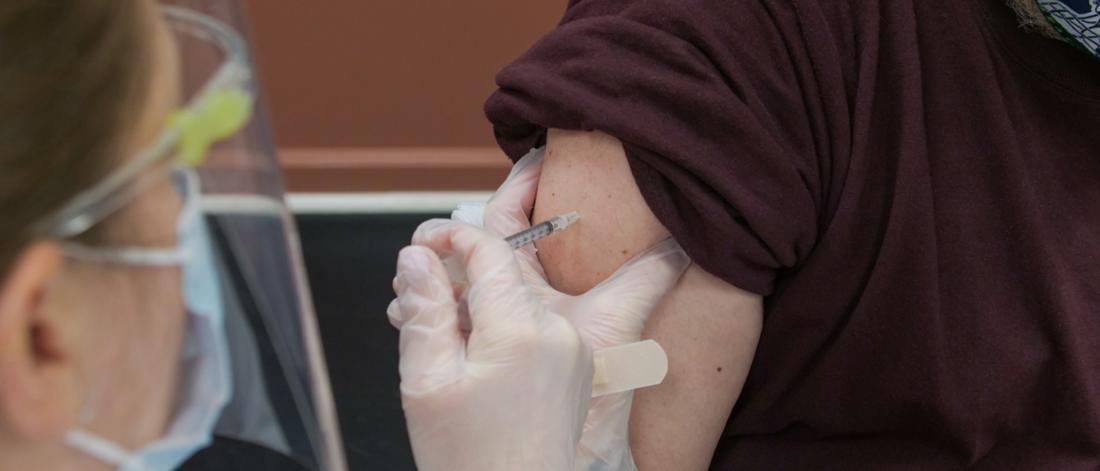COVID-19 research
Researchers at the University of Manitoba are using three specific COVID-19 datasets and other regular data from the Manitoba Population Research Data Repository for several provincial and multi-jurisdictional COVID-19 related research projects.

COVID-19 data
COVID-19 lab testing and results data - contains COVID-19 lab test information and results, dates, acquisition information and patient date of birth, postal code and group (e.g., health care worker, general public.).
COVID-19 lab testing and results data description
COVID-19 surveillance data - cases and contacts - contains case and contact investigation information, such as infection and acquisition classifications, symptoms, risk factors, exposure, interventions and transmission assessments.
COVID-19 surveillance data - cases and contacts data description
COVID-19 vaccinations, appointments and screening data - weekly updates - contains vaccination data related only to COVID-19 vaccinations in Manitoba and includes the number of doses received, delivery location and organization, immunization reason, SNOMED code and description, and vaccination date. Data related to COVID-19 vaccination appointments and screening data is also included. All this data is currently updated weekly.
COVID-19 vaccinations, appointments and screening data description
Other COVID-19 updates to the data repository
Some of our regular repository data is being updated on a monthly or quarterly basis. This includes all relevant data, not just cases related to COVID-19. This data includes the:
- Manitoba Health Insurance Registry (i-Registry),
- Medical claims/medical services (includes services related to COVID-19),
- Critical care and medicine (ICU data),
- Drug Program Information Network (DPIN) prescriptions,
- Emergency Department Information System (EDIS), and
- Immunizations data.
For more information, please see the Coronavirus (COVID-19) Coding and Data Sources concept in the MCHP Concept Dictionary.
COVID-19 research projects
There are several COVID-19 provincial and national research projects underway using the Manitoba Population Research Data Repository, including:
Projection of COVID-19 pandemic and possible interventions in Manitoba
Mahmoud Torabi
In the conventional infectious disease models, an underlying assumption is that the infection rate will stay constant during the epidemic which may not be true. In particular, in the case of COVID-19, infection rates may change over time and may also depend on the characteristics of infected people. Our research goal is to better understand the behaviour and pattern of COVID-19 pandemic in Manitoba to be able to inform policy makers for possible interventions.
Our two specific aims are:
- to develop the ILMs [Individual Level Models] to improve the SEIR [Susceptible-Exposed-Infected-Removed] model for projection of coronavirus accurately in Manitoba, identify vulnerable Manitoba population affected most by this virus, and also find spatial pattern of coronavirus in Manitoba; and
- to use the developed ILMs in aim one to improve the ABM [Agent Based Models] for projection of COVID-19 in Manitoba, identify vulnerable populations in Manitoba, and recommend possible interventions to control the spread of virus in Manitoba.
Evaluating the impact of the response to the COVID-19 pandemic on Manitobans diagnosed with cancer
Kathleen Decker
Project aims:
- Evaluate the impact of interventions implemented in response to the COVID-19 pandemic on cancer incidence, patterns of cancer care, time to first treatment, and survival for individuals diagnosed with cancer.
- Evaluate the impact of COVID-19 related interventions on a potential shift in stage at diagnosis for individuals diagnosed with breast, colorectal, and cervical cancer.
- Determine if time to first treatment and survival were more greatly affected by COVID-19 related interventions for subpopulations of individuals diagnosed with cancer.
- Evaluate the association of COVID-19 related interventions on health care utilization for individuals diagnosed with cancer.
- Determine the average cost per cancer patient during the COVID-19 time period.
- Describe the experience of individuals receiving chemotherapy or radiation therapy during the pandemic with a) coordination of care and information provision by healthcare providers and b) determine what is helpful and unhelpful when receiving virtual cancer care.
Deferred care outcomes in Canadian children and youth: measuring and mitigating risk during COVID-19
Marni Brownell (local Manitoba Primary Investigator); Astrid Guttmann (national Primary Investigator)
To provide timely analyses using population-based data from Ontario (ON) and Manitoba (MB) on the impact of deferred care through examination of all pediatric health care service use, time sensitive primary care visits (early newborn follow up, immunizations and developmental assessment) and severe presentations of pediatric illness to inform health system mitigation strategies as the pandemic continues. We include both aims that are largely descriptive in nature and amenable to policy relevant reporting for local health authorities but also analytic ones to test hypotheses that can be used to target populations at risk of poor outcomes and inform identification of potential inequities during ongoing surveillance.
Project aims:
- Provide overall context of all pediatric (0-18 years) health care use during the pandemic compared to baseline and test differences by age, health status, family socio-demographics and geography.
- Estimate pandemic-related severe presentations of illness in all children and those with chronic conditions that reflect deferred care.
- Estimate the extent of deferred preventive primary care (e.g., early newborn follow-up, immunization visits) and test associations with primary care characteristics, and family socio-demographics.
- Refine the list of deferred care outcomes and most relevant equity lenses/stratifications with input from key knowledge users to inform the subsequent two rounds of analyses as the pandemic and associated restrictions and mitigation strategies evolve in ON, MB; and develop a data strategy and analytic tools for use across Canada.
A distinction-based study on equity in COVID-19 testing and associated outcomes for Manitoba First Nations, Metis and Inuit
Nathan Nickel
Our goal is to provide real-time, whole-population evidence on COVID-19 diagnostic testing among First Nations, Métis and Inuit Manitobans to inform the scale-up of public health responses in these priority populations.
Our specific objectives are to:
- Examine the geographic distribution of testing among First Nation and Métis Manitobans, and Inuit in Manitoba, and compare each of these groups to all other Manitobans.
- Compare COVID-19 testing rates in Manitoba: First Nation Manitobans vs. all other Manitobans; Métis Manitobans vs. all other Manitobans; and Inuit vs all other Manitobans, after adjusting for region of residence and social determinants of health.
- Use predictive modeling to estimate the number of tests required for First Nation Manitobans, Metis Manitobans, and Inuit in Manitoba, based on how the pandemic progresses (i.e., clustering of COVID-19 cases) and accounting for family-level clustering; identify the additional number of tests required if best-practice guidelines were followed.
- Develop analytic algorithms and macros that can be applied to administrative health records to auto-monitor testing rates.
Predictors of COVID-19 incidence and severity: a population-based case-control study
Salah Mahmud
Our objective is to assess the association between socio-demographic factors, comorbidities, and use of drugs and vaccines and the risk of COVID-19 incidence and severe outcomes.
Specific aims:
- Assess whether hypertension and/or ACEIs/ARBs [Angiotensin-Converting Enzyme Inhibitors (ACEIs)/ Angiotensin II Receptor Blockers (ARBs)], increase the risk of COVID-19 diagnosis and COVID-19-related hospitalization, Intensive Care Unit (ICU) admission or death.
- Assess whether other comorbidities and frailty increase the risk of COVID-19 diagnosis and COVID-19-related hospitalization, ICU admission, or death, and whether these factors are responsible for worse outcomes among LTCF (Long Term Care Facility) residents.
- Assess whether influenza and pneumococcal vaccination and previous lab-confirmed respiratory or systemic infection increase the risk of COVID-19 diagnosis and COVID-19-related hospitalization, ICU admission, or death.
Evaluating the differential impact of what we have done, as we prioritize what to do next: a multi-provincial intervention modeling study using population-based data
Alan Katz (local Manitoba Primary Investigator); Sharmistha Mishra (National Primary Investigator)
The overarching goal of our interdisciplinary and multi-provincial team is to support epidemic responses through detailed investigation of the sources and epidemic consequences of heterogeneity in acquisition, spread and severity.
Our aims are to:
- Identify individual- and neighbourhood-level sources of heterogeneity in the relative risk of COVID testing, diagnoses, and severity (hospitalization, death) within and between provinces. (Approach: statistical modeling).
Evaluating the impact of COVID-19 on health care utilization psychotropic drug use, and mortality among individuals living with mental illness: a population-based study using administrative data
Christine Leong
Our aims are:
- To determine if the quarterly rates of dispensing of psychotropic and non-psychotropic medications changed from 2015/16 to 2019/20 in the general population and among people with a previous mental health diagnosis.
- To determine the change in adherence and rate of discontinuation of psychotropic medication among those who received a psychotropic medication in the year prior to the first COVID-19 case in Manitoba.
- To determine if the annual rates of physician visits, hospitalizations, emergency visits, and mortality changed from 2015/16 to 2019/20 in the general population and among people with a previous mental health diagnosis.
Developing strategies to support First Nation communities' decision-making during COVID-19 outbreaks
Josie Lavoie
Although as of May 4, Manitoba First Nation reserve communities have yet to experience a single COVID-19 case, communities are preparing for outbreaks. Communities are expecting a disproportionate number of severe cases, based on the experience of H1N1. The COVID-19 pandemic has highlighted the importance of modeling in estimating the course of the infection over time, the potential impact of public health measures and the resources required to meet response needs. This proposal then aims to mobilize First Nations leadership, Indigenous health research, modeling, health services research and health economic expertise to support First Nations planning and decision-making on COVID-19 management in their communities and at the provincial level.
We plan to:
- Construct detailed community profiles of acute respiratory infections, community size, remoteness, access to health care, risk factors associated with severe COVID-19 infection, and local infrastructure limitations impacting communities’ ability to respond (safe drinking water, crowding, existing facility to be used for isolation), to support First Nation-centric model developments;
- Develop a web-based secure tool for modeling community outbreaks;
- Estimate the potential financial and social burden on First Nation communities, in view of ensuring adequate resourcing to support local responses;
- Develop a sustainable Manitoba-led, First Nation modeling infrastructure that can be mobilized quickly to assess the potential impact of outbreaks and pandemics, estimate resource planning needs, and be scaled nationally.
It is imperative that First Nation leaders be equipped as soon as possible with the best possible planning tools. Public health communications to date from federal and provincial governments have been high levels, and virtually silent on the need to contextualize recommendations to local circumstances.
The impact of population-level physical distancing during COVID-19 pandemic on health care services in Manitoba: a focus on vulnerable populations
Sherif Eltonsy
Using the Manitoba linked administrative health databases, we aim to examine the trends of health care utilizations and the clinical impacts of the physical distancing measures implemented during the COVID-19 pandemic, with a special focus on vulnerable population groups (e.g., older adults, pregnant women, persons with disabilities, remote communities and low socioeconomic status groups.)
Specific objectives of the proposed project:
- Overview of the pandemic consequences, specifically as it relates to drug utilization: Examine the trends of dispensing important medications during the COVID-19 pandemic, with focus on vulnerable populations.
- Examine the effects of COVID-19 physical distancing measures on perinatal health and services: we will (a) compare the rates of perinatal and postpartum health services pre-COVID and during COVID and (b) compare maternal and neonatal outcomes of births occurring pre-COVID and during COVID.
- Investigate the impact of public health measures reducing in-person health care services during COVID-19 in priority populations: we will investigate the impact of changes in reducing elective surgeries and in-person patient care on priority populations.
Contact us
Manitoba Centre for Health Policy
Rady Faculty of Health Sciences,
Room 408-727 McDermot Ave.
University of Manitoba
Winnipeg, MB R3E 3P5 Canada
Request information in an accessible format
If you require access to our resources in a different format, please contact us:
- by phone at 204-789-3819
- by email at info@cpe.umanitoba.ca
We strive to provide accommodations upon request in a reasonable timeframe.

